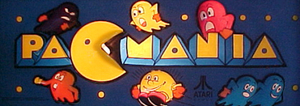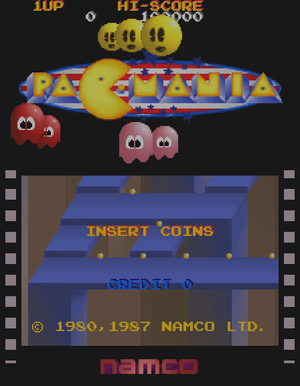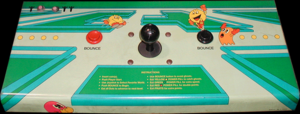Lost In Translation/Pac-Mania
| Pac-Mania | |
|---|---|
| Manufacturer | Namco |
| Released | 1987 |
| Control Method |
8-way Joystick 3 Button(s) |
| Main CPU | (3x) M6809 (@ 1.536 MHz) HD63701 (@ 1.536 MHz) |
| Sound CPU | Stereo YM2151 (@ 3.580 MHz) Namco CUS30 (@ 12.000 kHz) DAC |
| Video Details |
Raster (Vertical) 288 x 224 pixels 60.61 Hz 8,192 Palette colours |
| Screens | 1 |
| ROM Info | 13 ROMs 1,249,280 bytes (1.19 MiB) |
| MAME ID | pacmania · pacmanij |
About The Game
Pac-Mania is a pseudo-3-D maze-based arcade video game.
He's back in action... but with a new twist, BOUNCE power! Ready for a new generation of Pac-Man players, he can't wait for the chance to show off his new aerial maneuvers to the crowd! The "boss" ghost Clyde has recruited the talents of 2 new ghosts, Sue and Funky. Pac-Man must use his speed and cunning to outwit these annoying pests.
Pac-Man now faces new challenges as he enters the worlds of Block Town, Pac-Man's Park, Sandbox Land, and Jungly Steps. Fortunately for Pac-Man, he has the help of 2 'special items' - a green and red power pill. The green pill adds temporary speed, and the red awards double points. It's a whole new ball game for Pac-Maniacs!
Game play begins with the opportunity for players to level select among one of three playfield worlds : Block Town, Pac-Man's Park or Sandbox Land. With Block Town being the easiest and Sandbox Land being the harder, players are accordingly rewarded for selecting and completing the challenges in this mode.
The player's main objective is to eat all dots and power pills in the mazes while avoiding persistent ghosts. Using the new BOUNCE button, players can bounce their way over the ghosts to avoid being caught. But two new ghosts have been added to insure that Pac-Man doesn't have it too easy. In fact, one of them can also bounce in the air like Pac-Man. Fortunately, these rivals of Pac-Man are only found in the more demanding worlds and mazes.
During play, the appearance of fruit and green/red power pills will trigger the bell. This alerts players immersed in the game who might otherwise miss these valuable items. A green power pill awards extra speed; it is good until a yellow or red power pill is eaten and expires or a game life is lost. Red power pills award double points, and continue to do so until a game life is lost.
An optional continue feature is offered to allow players to continue their progress without having to start back at the beginning. It's a great way for Pac-Maniacs to learn and practice strategies without having to re-start games from the beginning. Bonus thresholds are offered at various score values, and are adjustable.
Trivia
Released in November 1987.
Licensed to Atari for US distribution.
After the superb platform action of the series' previous game, "Pac-Land", Namco chose to return the series to its roots with the re-introduction of the 'eat all of the pills in the maze game-play of the earlier classics. Pac-Mania feels somewhat different to its illustrious predecessors, however, due to Pac-Man's newly-acquired 'jump' ability. The mazes are now rendered with a pseudo-isometric viewpoint, allowing the player to jump over the chasing ghosts and make an escape.
The 'Pac-Man's Park' maze is basically the original "Pac-Man" maze.
Another new feature in this game is the appearance of several 'special items' (in addition to the traditional fruit bonuses - cherries, strawberries, oranges, apples, bananas, apricots, bells, and keys). These items include candy, hamburgers, ice cream cones, coffee, and 2 special kinds of power pills. The pills, which appear in addition to the traditional power pills, give Pac-Man more points for eating ghosts and also give him extra speed, both of which come in very handy during game-play. Pac-Mania was to be Pac-Man's last arcade outing.
Donn Nauert holds the official record for this game with 385,570 points.
Victor Entertainment released a limited-edition soundtrack album for this game (Namco Video Game Graffiti Vol.4 - VDR-5282) on 08/03/1989.
Updates
Difference Between US and Japanese Version :
- US version
- The first Block Town only has 1 Level.
- The first Pac-Man's Park, Sandbox, and Jungly Steps Worlds only have 2 levels each.
- Spunky shows up on the second Sandbox World level.
- Top 10 Score List. Will let you write initials, before continuing.
- The "Pac-Mania" Logo has Pac-Man, Pinky, and Blinky circling around the logo.
- There's Stage Select
- Items are placed differently
- Courage Bonus this would activate once you got past Block Town.
- Total Levels : 19
- Japanese version
- First Block World has 2 levels. And every other world after that has three levels.
- Spunky shows up on the third Jungly Steps level
- No Stage Select. However, if one Japanese Machine has Stage Select, you cannot continue.
- No Top 10 Score List.
- The 'Pac-Mania' Logo doesn't have Pac-Man, Pinky, and Blinky circling around the logo.
- Total Levels : 23
Scoring
| Item | Points |
|---|---|
| Dot | 60 |
| Power pill (energizer) | 300 |
| Red pill (special energizer) | 7,650 (doubles ghost values up to 7,650) |
| Green pill (speed up) | 1,000 |
| Ghosts | 200, 400, 800, 1,600, 3,200 & 7,650 |
| Cherry | 1,000 |
| Strawberry | 2,000 |
| Peach | 3,000 |
| Apple | 4,000 |
| Banana | 5,000 |
| Flower | 6,000 |
| Bell | 7,000 |
| Key | 8,000 |
| Candy | 4,000 |
| Green apple | 6,000 |
| Coffee cup | 5,000 |
| Small ice cream cone | 6,000 |
| Large ice cream cone | 8,000 |
| Silver bell | 9,000 |
| Galaxian | 7,650 |
| Silver key | 10,000 |
| Hamburger | 7,000 |
| Silver Galaxian | 7,650 |
Tips and tricks
- On the first couple of stages where power pellets last long, try to get 3 or 4 ghost near a power pellet. Once they are there, it is possible to eat all of the ghost on the board. You'll also rack up lots of points this way after eating the Pink Pill.
- On later stages, try clearing the pellets on top of the maze first. Not all of the ghost will come out at once, once the level starts.
- On later stages, power pellets won't last long. Use those to distract the ghost as you clear the board.
- Jumping is very important. You can jump at least 3 ghost lengths.
- When a ghost is on your tail, a good way to lose him is to turn around and jump over the ghost.
Series
- Puckman (1980)
- Ms. Pac-Man (1981)
- Super Pac-Man (1982)
- Pac-Man Plus (1982)
- Jr. Pac-Man (1983)
- Pac & Pal (1983)
- Pac-Land (1984)
- Pac-Mania (1987)
- Pac-In-Time (1994, Nintendo Super Famicom)
- Pac-Man 2 - The New Adventures (1994, Nintendo Super Famicom and Sega Mega Drive)
- Pac-Man VR (1996)
- Pac-Man World (1999, Sony PlayStation)
- Pac-Man - Adventures in Time (2000, PC CD-ROM)
- Ms. Pac-Man Maze Madness (2000, Sony PlayStation)
- Ms. Pac-Man - Quest for the Golden Maze (2001, PC CD-ROM)
- Pac-Man All-Stars (2002, PC CD-ROM)
- Pac-Man Fever (2002, Sony PlayStation 2)
- Pac-Man World 2 (2002, Sony PlayStation 2, Nintendo GameCube, and Microsoft XBOX; 2004, PC CD-ROM)
- Pac-Man vs. (2003, Nintendo GameCube)
- Ms. Pac-Man - Maze Madness (2004, Nintendo GameBoy Advance)
- Pac-Man World 3 (2005, Sony PSP, Sony PlayStation 2, Nintendo GameCube, Microsoft XBOX, PC CD-ROM, and Nintendo DS)
- Pac'n Roll (2005, Nintendo DS)
- Pac-Pix (2005, Nintendo DS)
Staff
- Game Design
- St. Daimyojin
- Character Design
- T. Yamashita
- Graphic Design
- A. Usukusa
- Visual Design
- Satoshi S.
- Babe. Teshima
- Yukari M.
- Kazuya G.
- Tomoyuki S.
- Music & Sound
- Junko Ozawa
- Yuri.
- Y. Tomuro
- Game Program
- Taro. Shimizu
- System Program
- Taro. Shimizu
- Kosei M.
- Dr. Tam.
- H. Yamazaki
- System Design
- T. Ogawa
- T. Okada
- Makoto Inoue
- Dr. Tam.
- Director
- St. Daimyojin
- T. Iwatani
- Presenter
- Fun First Pro.
- Namco Limited
Cabinet and Artwork
Ports

- Consoles
- Nintendo Famicom (1990)
- Sega Master System (1991)
- Sega Mega Drive (1991)
- Sony PlayStation (1997, "Namco Museum Vol.5")
- Nintendo Game Boy Advance (2001, "Pac-Man Collection")
- Sony PlayStation 2 (2002, "Namco Museum")
- Microsoft XBOX (2002, "Namco Museum")
- Nintendo GameCube (2002, "Namco Museum")
- Sony PlayStation 2 (2005, "Namco Museum 50th Anniversary")
- Microsoft XBOX (2005, "Namco Museum 50th Anniversary")
- Nintendo GameCube (2005, "Namco Museum 50th Anniversary")
- Computers
- Sinclair ZX Spectrum (1988)
- Atari ST (1988)
- Amstrad CPC (1988)
- Commodore C64 (1988)
- Commodore Amiga ("Pac-Mania", 1988, Grandslam)
- MSX2 (1989)
- Acorn Archimedes (1991)
- Tandy Color Computer 3 (1992, "PacDude Monster Maze")
- Sharp X68000
- PC [MS Windows, CD-ROM] (2005, "Namco Museum 50th Anniversary")
- Others
- Mobile Phones (2005)
Soundtrack Releases
| Album Name | Catalogue No. | Released | Publisher | Comments |
|---|---|---|---|---|
| Namco Video Game Graffiti Volume 4 | VDR-5282[1] | 1989-03-08 | Victor | CD version. |
| Namco Video Game Graffiti Volume 4 | VCH-1907[2] | 1989-03-08 | Victor | Cassette version. |
| Namco Video Game Graffiti Volume 4 | SJX-25050[3] | 1989-03-08 | Victor | Vinyl version. |
| The Best Of AY-3-8912 | CZCD 005[4] | 2007-07-12 | Binary Zone Interactive | CD version. |
Sound Comparison
| Platform | Song Titles | Sound Source | |||||||||||
|---|---|---|---|---|---|---|---|---|---|---|---|---|---|
| Arcade | "Game Start" | "Block Town (World 1)" | "Pac-Man's Park (World 2)" | "Sandbox Land (World 3)" | "Jungly Steps (World 4)" | "Demo 1" | "Demo 2" | "Demo 3" | "Congratulations (Ending)" | "All Clear" | "Game Over" | "Name Entry" | M1 v0.7.8a6 |
External Links
- Sinclair ZX Spectrum version of Pac-Mania at the World of Spectrum








